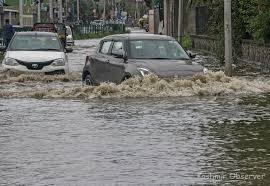Srinagar, September 12, 2025 : After three days of incessant rain triggered a flood-like situation in the Kashmir Valley, environmentalists are demanding a comprehensive flood management strategy for Jammu and Kashmir.
Thousands were evacuated following a breach in the Jhelum embankment near Srinagar, with homes inundated and streams rising rapidly, spreading panic across the region. Environmentalists warn the situation is even more alarming than the devastating 2014 floods.
The Kashmir-based Environmental Policy Group (EPG) called for an immediate ban on land allocation, transfer, or construction within 500 meters of wetlands. Faiz Bakshi, EPG’s convenor, emphasized the absence of a coherent policy and urged the creation of small storages in basins to regulate water flow. He proposed pairing mini-dams with solar-powered hybrid pumped storage systems to simultaneously tackle flood and power challenges.
Wular Lake, Bakshi added, plays a vital role in flood absorption by holding excess water and releasing it gradually.
The Peoples’ Environmental Council (PEC) has recommended institutionalised community-government collaboration, restoration of wetlands and floodplains, preserving natural water flows, and developing a climate-resilient sponge city model.
A senior activist stressed that urgent, practical steps must be taken to prevent such crises following short periods of rainfall.
Chief Minister Omar Abdullah acknowledged the lapse in action since the 2014 floods and vowed to hold past administrations accountable, noting, “It seems that 11 years have been wasted by previous governments.”



















